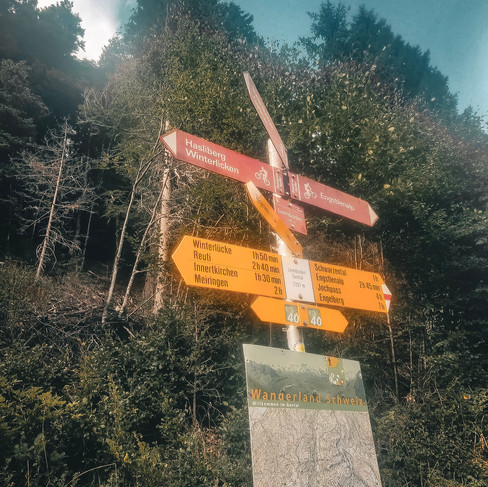
My discovery of Switzerland was all entirely by accident. This wasn’t my first trip to Switzerland. One of my best friends is Swiss and she took me on a whistle-stop skiing tour to the pretty and picturesque village of Bettmeralp, just before Covid became a thing. At the start of the Summer in 2023, she invited me back for a multi-day hike in Ticino, the Italian speaking part of Switzerland. During my weeks stay in this beautiful part of the world, I made more Swiss friends and just a few weeks later, I was coaxed back to the country in my camper-van.
When you mention Switzerland, often people will simply mention the sky high prices and many will expect the whole country to be covered in snow all year round. You can’t deny it is an expensive place to travel - I stayed in Zermatt for two nights in July and felt like I could barely afford to eat, but in my opinion, there are ways around making a trip to this magical country easier on the wallet.
I could talk about the ins and outs of why I love Switzerland as a whole, but for now, I’ll just focus on why it should be at the top of your trail running list.
1. Volume and variety of trails 📈
With over 65,000 kilometres of trails in the small country of Switzerland, it is virtually impossible to get bored, simply by the volume and variety of trails on offer. The changeable and dynamic landscapes mean you can choose from running over rugged peaks, along exposed ridges or through green pastures, all in the course of one day.
During my summer in Switzerland, I was fortunate to run through valleys, race alongside raging rivers, climb over mountain passes, sprint across swing bridges and weave through dense forests. The views and excitement of what could be next on the trail never left me and I knew each area in this incredibly beautiful country would leave me speechless and make me never want to leave. If you want diversity, fun trails and breathtaking scenery when running, Switzerland will provide all of these things and so much more.
2. Maintained trails 🛠️
Experienced trail runners and adrenaline junkies probably enjoy trails which are sketchy, but for me being a relative newbie to running in the mountains, knowing that the trails were well maintained and ‘safe’ made my trail running experience in Switzerland so much more enjoyable. I’ve hiked and run in quite a few regions in Europe now and it’s surprising how varied the quality of trails can be. In France, some of the routes seem laughable, where you constantly doubt whether you’re still actually on the trail or if you've gone off piste.
Switzerland pride themselves on creating an outdoor environment which is safe and assessable for all to enjoy. Teams work in every corner of the country, to maintain trails and ensure the environment is a paradise for hikers, runners and every type of outdoor enthusiast. From making sure the terrain is safe, securing loose rocks to refreshing the colours of the markers to make navigation easy, everything is fully thought through.
Maintaining trails isn’t cheap, but the Swiss see this as an investment for their own country, encouraging the population to keep fit and healthy, whilst also appealing to the millions of tourists who visit this insanely beautiful country each year. Prices may be expensive in Switzerland, but with each km of trail costing approximately $800 every year to maintain, you can quickly see why you pay a premium to stay and explore this amazing paradise.

3. Navigation 🧭
When heading abroad and looking for trails to hike and run, my default will be to head straight to AllTrails to search for the best routes and itineraries. I may be in the minority, but I actually find the AllTrails app pretty clunky and hard to use, especially as you can’t easily plot your own route. In the UK, we have a trail app called OS Maps which is a bit old school, but fully functional and accurate, all at the cost of a yearly subscription fee.
Recommended by my Swiss friends, is the Swiss Mobility App. The app itself is free, but like many apps these days, you need to pay a fee to unlock premium features, such as being able to plot routes and download the routes so they are available offline.
The standard features are, however, extremely helpful and for my trip, it made planning and choosing routes super easy. You can switch between summer and winter modes, to show trails relevant for the season and also select the activity you are undertaking (hiking, road biking, mountain biking for example) to show the right type of trails on the map.
For trail running, I always had the hiking trails selected, which are categorised into three categories: yellow hiking trails, red hiking trails and blue climbing routes. The yellow hiking trails are typically recreational hikes, where the trails are wider, with flat or gentle slopes and there is a low of falling. For context, I chose many of these trials for my running ventures, purely because the trails were easier to follow, less technical but still super fun. Most of the trails you’ll find are ‘red’ in the Swiss mobility app, and signposted on the trail with red and white stripes. There are fewer blue trails which are typically in the high mountains and climbing experience and equipment is recommended to conquer these trails.
This clever little app also shows when trails are closed, which is especially handy after poor weather. I experienced this myself in Ticino, with many trails being damaged after quite a frightening hail storm. Knowing not to venture to some of the more adventurous trails in advance, was definitely helpful and saved getting caught out or a very long hike or run back. The app also links up with Swiss public transport app, which is very convenient when planning a short cut back to civilisation.
Like I mentioned above, the trails in Switzerland are maintained to an extremely high standard and to help find your way safely along your desired route, there are signposts at regular intervals which tell you roughly how long it'll take to get to each destination.
4. Public transport 🚡 🚌
Now I’ve started writing this paragraph, I realise I should have started with a disclaimer that is was likely to be one of the less ‘sexy’ articles, with a whole section on public transport. Joking aside, the public transport does make running in some hard to reach areas super easy, convenient and possible.
If you’ve had a chance to read any of my other articles, you will have gathered that I’m a big fan of running the length of valleys and point to point runs. Unless you’re a hard core ultra runner (sadly I’m no where near that category) and enjoy double the fun of running an out and back, you’ll need to figure out some logistical challenges to get you back to where you’re staying for the night.
As well as it’s incredible natural beauty, excellent engineering and high quality products, Switzerland is also renowned for its efficient and reliable public transport. Whether it’s cable cars taking you up to high altitudes, trains to transport you across the country or buses connecting you to hard to reach spots, you can guarantee that your scheduled departure and arrival will be perfectly on time.
5. Mountain huts and refuges 🛖
Switzerland has over 200 mountain huts or refuges, many of which are located high in the mountains and where it feels like you are a million miles away from civilisation.
This summer, I was fortunate to stay in a mountain refuge for the first time and I can only describe it as an unforgettable experience. Arguably, I did hike to the refuge with a good friend, but staying in one of these idyllic mountain huts can definitely be utilised as part of a trail running adventure, if you're capable of packing light.
Typically in the hut, you will be given a bunk for the night and in the height of Summer, you can expect to share the room with others. Of course your room mates will have also travelled on foot, so you can expect most people to enjoy the evening in the hut but will most likely be in bed not much later than 10pm. Food is typically very good and hits the spot after a long day in the mountains.
It's hard to truly picture the sheer isolation of some of these huts and the incredible feat of engineering undertaken to construct these buildings in high altitudes and remote locations. There are no roads to many of these structures, so in pure Swiss style, supplies are often bought in by helicopter.
Like I've mentioned, Switzerland certainly won't be the cheapest place you encounter and the same applies to staying in mountain huts. In my opinion, however, everyone should stay in one of these serene spots at least once in their life. Including a stay as part of a trail run is entirely possible but may just need a little more forward planning and require you to pack light.

Capanna Cristallina CAS, situated at 2,575m






























Comments